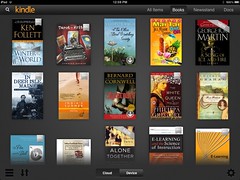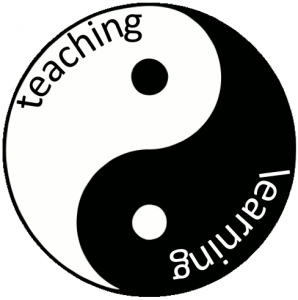Sheryl Nussbaum-Beach described her New Year’s commitments and challenged the rest of us to do the same. As always, she makes a powerful statement and I found myself nodding my head in agreement as I read. Dealing productively with digital and emotional distractions, finding a work/life balance, and pursuing excellent in everything…these are all worthy goals. She sums it up beautifully: “I am determined to influence the world this year rather than be influenced by it.”
I have three goals for the new year: create, connect and commit.
Make Art Dammit!
This is the mantra from The Daily Create, an offshoot of ds106, a MOOC that originated at the University of Mary Washington. Each day, they post an assignment designed to inspire “spontaneous creativity.” Today’s assignment is to illustrate a decision. Mine is a screenshot of my Kindle app and wondering what to read next…
As part of ds106 GIFfest, I had fun making my first animated gif in a very long time. It reminded me that I enjoy creating: from crocheted doilies to homemade bread to flower gardens to digital media. And, I have lots of opportunities to be creative, as long as I make the time. Along with Sheryl, I’m going to stop thinking there isn’t enough time…I value creativity so making it part of my daily life is important. In a larger sense, by creating these things, I am creating a life.
Create Connections
One of the great things about doing The Daily Create is that you do so as part of a community. It was a real kick to get positive comments on my animated gif along with suggestions for how to extend the creativity. Creating is fun but being part of a creative community is even more fun. Writing this blog post is part of this goal: a way to connect with others at the start of the new year, a year in which I want to do more connecting. More blog writing, more twitter sharing, more community creating. I have recently started exploring Google+ as well. I do a lot of connecting as part of my work, bringing people together in courses and webinars and conferences, but I want to do it more personally, including getting more involved in the crochet group I joined last year.
Increasingly, our farm is becoming a place to make connections. We have gotten to know many members of our local community when they come by to get vegetables. We have also made connections with other local farmers, and the first thing I did this morning was sign up for beekeeping classes so I can get my hives up and running this year. This past summer, we donated our excess harvest to the food bank in town. I want to strengthen those local community ties, perhaps as part of a local anti-poverty or literacy initiative. Moving to the country has opened my eyes to rural issues. I’m not sure of the details yet but am committed to finding my niche in our new place.
Forge Commitment
When I look back at my reading list for 2012, it is filled with great books. But most of them are fiction. Meanwhile, there is a whole host of writing calling for my attention: get back to Kozol, dig further into the banned book list, spend time with contemporary writers about education and change, and work on the shelf of Wendell Berry’s books. I feel a deep connection to Berry as both a writer and a farmer.
This reading will help fuel my writing. I committed to a daily blogging practice this fall and then life and work got in the way. I am re-committing to that practice as I move into the new year. Writing is a way to both create and connect so offers a foundation for my other goals.
So, a public declaration of my goals for the new year…what about you? Want to join me in any of these endeavors?

